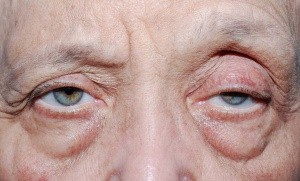What is Ptosis (Toe-sis)?
Ptosis is drooping of the upper eyelid. A normal eyelid height varies among the population, but usually the upper eyelid rests at least 3 millimeters above the center of the pupil. A small degree of ptosis may not cause symptoms, but greater amounts can obstruct the vision and interfere with daily activities including reading, computer use, and driving. Although ptosis can be present from birth (congenital), most often it occurs with aging (involutional or adult onset). It can affect one or both eyes and may be very asymmetrical. The most common cause of adult onset ptosis is stretching or weakening of the upper eyelid muscle (levator) that lifts the eyelid. Less common causes include muscular/neurological diseases (myasthenia gravis), vascular diseases (stroke), tumors of the lid or orbit and direct trauma to the eyelid.
When is ptosis of concern?
If a droopy eyelid occurs gradually, is constant and is not associated with any other symptoms (such as pain or redness of the eye, asymmetry of the pupils, double vision or systemic symptoms) no immediate evaluation or treatment is necessary. Any ptosis that is of rapid onset, is variable or is associated with other eye or neurological symptoms needs immediate attention.
How is ptosis treated?
Ptosis correction is surgical. Surgery is usually performed under local anesthesia in an outpatient surgical facility. The amount of drooping and the degree of muscle weakness will determine the exact surgical technique. For small amounts or ptosis with a relatively strong muscle, tightening of the muscle can be performed from underneath the upper eyelid without a skin incision. More significant ptosis associated with a weaker muscle is corrected by directly tightening the muscle through a skin incision. Rarely, the muscle is so weak that no amount of tightening will be effective; in those cases the eyelid
needs to be suspended from the eyebrow with an internal suture or other synthetic material.
needs to be suspended from the eyebrow with an internal suture or other synthetic material.
Is heavy upper eyelid skin the same as ptosis?
Dermatochalasis is excessive upper eyelid skin that often causes symptoms similar to ptosis but is a different problem with a different solution. Since it is also occurs with age, dermatochalasis can accompany true ptosis. Surgical correction requires
removal of the excess skin and can sometimes be performed at the same time as ptosis repair.
removal of the excess skin and can sometimes be performed at the same time as ptosis repair.
Is ptosis surgery covered by insurance?
Whether ptosis is considered functional and reimbursable by insurance or purely cosmetic can often be determined by a comprehensive eye exam along with special testing performed in the office. A visual field test is performed to map out the amount of loss of the upper field of vision and the eyelids are then lifted (taped) and the test is repeated. The visual field results along with measurements of the eyelid height will help to determine whether the surgery will be covered by an insurance carrier.
In summary, ptosis is a relatively common aging condition of the upper eyelid which can result in significant reduction of visual function. Most often it is not related to a serious eye or systemic condition and can be
surgically corrected under a local anesthetic.
surgically corrected under a local anesthetic.
Post by Dr. Philip Silverstone. Dr. Silverstone is a specialist in Ophthalmic Plastic and Reconstructive Surgery. For more information about treatment of ptosis, or any of the services we offer, contact us at any of our 4 offices in Milford, Orange, Branford, or Shelton.
We’re looking forward to hearing from you soon.


